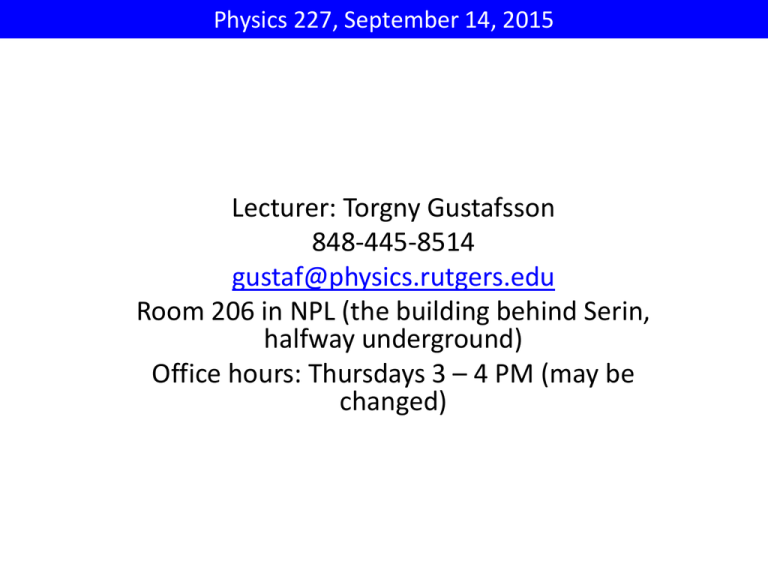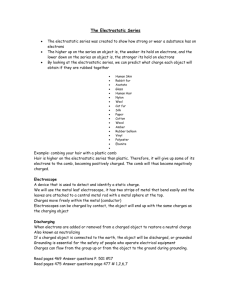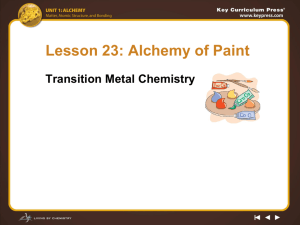Lecturer: Torgny Gustafsson 848-445-8514 Room 206 in NPL (the building behind Serin,
advertisement

Physics 227, September 14, 2015 Lecturer: Torgny Gustafsson 848-445-8514 gustaf@physics.rutgers.edu Room 206 in NPL (the building behind Serin, halfway underground) Office hours: Thursdays 3 – 4 PM (may be changed) The first midterm!!! The first common hour midterm exam will be held on Thursday October 1, 9:50 to 11:10 PM (at night) on the Busch campus. You should go to the room corresponding to the first 3 letters of your last name. If you have a conflict with the exam time, please contact Prof. Cizewski Cizewski@physics.rutgers.edu with your entire schedule for the week of September 28 at your earliest convenience but not later than 5:00 pm on Wednesday, September 23. Aaa – Hoz Hua – Moz Mua – Shz Sia – Zzz ARC 103 Hill 114 PHY LH SEC 111 Lecture 4. Conductors in Electrostatics General problem of Electrostatics: Given: objects that carry charges (point-like, extended, different materials) Find: the electric field everywhere. To solve the problem, we need to combine the field equation (Coulomb’s Law = Gauss’ Law) + the “materials” equation (macroscopic description of the matter’s response to the electric field) The simplest materials equation corresponds to the case of metals (conductors) in the electrostatic field. 3 Reminder: Gauss’s law 𝑸𝒏𝒏𝒏 � 𝑬 𝒓 ∙ 𝒅𝑨 = 𝜺𝟎 4 Matter in Electrostatic Field Conductors Dielectrics Mobile electrons Induced/built-in dipoles Electric field → current Electric field → polarization Though the mechanisms of polarization in metals and dielectrics are different, we can treat metals (for now) as an extreme case of highlypolarizable dielectrics. 6 Conductors (Metals) in Electrostatics Metals: huge number of free-moving electrons (conducting electrons). ? - - ++ E=0 + + + E=0 inside a metal - the “materials” equation If a piece of metal is placed in electric field, the electrons will be redistributed (current flows) until the field is 0 everywhere inside the metal. The equilibrium charge distribution: no net charge in the volume, the surface is charged in such a way that the field of this surface charge compensates the external field in the volume (the electric field lines are terminated and originated at the surface). 7 Neutral Conducting Sphere in the Field of a Point Charge Field of Point Charge Ignore the cavity! Field of Surface Charges + Net Field (E=0 inside metal) E=0 http://web.mit.edu/viz/EM/vi sualizations/electrostatics/ ChargingByInduction/shield ing/shielding.htm 8 Surface Charge Density σ 𝒚 Metal External field (without a metal) 𝑬 𝑬𝒏𝒏𝒏 Superposition: 𝐨𝐨𝐨𝐨𝐨𝐨𝐨: 𝑬𝒏𝒏𝒏 𝜎 𝐸𝑆 = 2𝜖0 𝝈 𝜎 𝐸𝑆 = 2𝜖0 𝑬 𝒚 𝐨𝐨𝐨𝐬𝐬𝐬𝐬 𝝈 𝝈 =𝑬+ = 𝟐𝝐𝟎 𝝐𝟎 𝑬𝒏𝒏𝒏 = 𝟐𝑬 𝐢𝐢𝐢𝐢𝐢𝐢 Field of surface charges 𝒚 𝐢𝐢𝐢𝐢𝐢𝐢: 𝑬𝒏𝒏𝒏 𝝈 = 𝟐𝝐𝟎 𝑬 𝝈 =𝑬− =𝟎 𝟐𝝐𝟎 Comparison: charged metallic and dielectric spheres Q Q Q Qr Q Q Q Uniformly charged (dielectric!) sphere Charged conducting sphere The same field outside if the net Q is the same. 12 How to Draw Field Lines near Conducting Surfaces Metal 𝑬𝒏𝒏𝒏 ? Metal 𝑬𝒏𝒏𝒏 would drive surface current Metal 𝑬𝒏𝒏𝒏 the only option At metallic surfaces the electric field is directed along the normal vector to the surface. The surface charge density (and, thus, the field intensity) is higher near protrusions: the electrons arrange themselves in the way that minimizes the total energy of this charge distribution. 13 3 atoms as seen by the Rutgers Helium Ion Microscope 14 Neutral Conducting Shell in the Field of a Point Charge Field of Point Charge Field of Surface Charges + Net Field: E=0 everywhere inside E=0 http://web.mit.edu/viz/EM/vi sualizations/electrostatics/ ChargingByInduction/shield ing/shielding.htm 15 Faraday Cage (Shield) Man-made “lightning”… .. and a real one Faraday cage in my lab 16 The first midterm!! The first common hour midterm exam will be held on Thursday October 1, 9:50 to 11:10 PM (at night) at four locations on the Busch campus. You should go to the room corresponding to the first 3 letters of your last name. If you have a conflict with the exam time, please contact Prof. Cizewski Cizewski@physics.rutgers.edu with your entire schedule for the week of September 28 at your earliest convenience but not later than 5:00 pm on Wednesday, September 23. Aaa – Hoz Hua – Moz Mua – Shz Sia – Zzz ARC 103 Hill 114 PHY LH SEC 111 Cavities (no Charges within the Cavity) 𝑎 𝑏 𝑄𝑛𝑛𝑛 = +𝑄 = 𝑄𝑖𝑖 + 𝑄𝑜𝑜𝑜 𝜎 𝑟=𝑎 =0 𝜎 𝑟=𝑏 = +𝑄 4𝜋𝑏2 Shell charge: +Q This conclusion holds for any inner surface: the charge density on the inner surface is zero provided no charges within the cavity. 18 Charges within Cavities +Q ++ - E=0 + + + In general, it is difficult to calculate the charge distribution on the surface of a conductor placed in an external electric field (see the Figure). We can easily find the net surface charge if we place a charge inside a metallic shell. 𝑄𝑖𝑖 = −𝑄 Our logic: + E=0 +Q + 𝑄𝑜𝑜𝑜 = +𝑄 + - Gaussian surface Φ𝐸 = 0 E=0 inside metal for any Gaussian surface inside metal 𝑄𝑒𝑒𝑒𝑒 = 0 = +𝑄 + 𝑄𝑖𝑖 𝑄𝑚𝑚𝑚𝑚𝑚 = 0 = 𝑄𝑖𝑖 + 𝑄𝑜𝑜𝑜 𝑄𝑖𝑖 = −𝑄 𝑄𝑜𝑜𝑜 = −𝑄𝑖𝑖 = +𝑄 19 Metal Shell as a “Black Hole” σout does not depend on the position of Q inside - for a spherical shell σout must be uniform (this minimizes the energy of this system of charges). The field outside is completely insensitive to the position/motion of charge Q inside! Thus, the metal shell divides the whole space into two regions: - “Outside” knows about the total charge enclosed, but cannot detect the charge position - “Inside” knows nothing about the magnitude and positions of the outside charges. 20 Problem 22.45: Concentric Spherical Shells Charge densities: 𝜎 𝑟=𝑎 =0 𝜎 𝑟=𝑏 = 𝜎 𝑟=𝑐 = Inner shell: +Q 𝜎 𝑟=𝑑 Outer shell: -Q 𝐸 𝑟 = 𝑏+ = 𝜎 𝑟=𝑏 𝑄 = 𝜀0 4𝜋𝜀0 𝑏2 1 𝑄 𝑄 � = 4𝜋𝜀0 𝑟 2 𝑟=𝑏 4𝜋𝜀0 𝑏2 Electric fields: +𝑄 4𝜋𝑏2 −𝑄 4𝜋𝑐 2 𝐸 𝑟<𝑏 =0 𝐸 𝑏<𝑟<𝑐 = 𝐸 𝑟>𝑐 =0 =0 𝑄 4𝜋𝜀0 𝑟 2 𝑬 𝒓 𝑎 𝑏 𝑐 𝑑 𝒓 22 Conclusion Metals in electrostatic fields: E = 0 inside. Next time: Lecture 5. Electric Potential §§ 23.1-23.4 23 Appendix I. More Complex Cases Field calculations based on the integral form of GL are not limited to these trivial cases: any charge distribution that can be considered as superposition of symmetrical charge distributions can be treated on the basis of this law. σ 2σ 1. Two infinite planes with the charge densities σ and 2σ. 𝐸= 𝜎 1+4 2𝜀0 2. Uniformly charged spherical shell with a small hole in it. Find E in the hole. Hole can be considered as (almost flat) “patch” of negative charge density (- σ) on top of a positively charged (σ) whole sphere. Field of the sphere Superposition! 𝑄 𝜎 𝐸𝑠 = = 4𝜋𝜖0 𝑅2 𝜖0 𝐸𝑠 = 0 𝐸𝑝 = 𝐸𝑝 = 𝜎 2𝜖0 𝜎 2𝜖0 𝐸𝑛𝑛𝑛 Field of the patch 𝜎 = 2𝜖0 24 Appendix II: Electric Field of a Charged Sphere with a Spherical Cavity Consider a uniformly charged sphere with a spherical cavity. Calculate the electric field intensity along the dashed line. R/2 Hint: treat cavity as a superposition of positively and negatively charged spheres. R positively charged sphere without a cavity negatively charged cavity E(x) sphere + cavity 𝑄 4𝜋𝜖0 𝑅 𝑄 𝑄/8 − 4𝜋𝜖0 𝑅 4𝜋𝜖0 𝑅/2 𝑄/8 − 4𝜋𝜖0 𝑅/2 𝐸 𝑥 R/2 R 𝑥>𝑅 𝑄 𝑄/8 = − 4𝜋𝜖0 𝑥 2 4𝜋𝜖0 𝑥 − 𝑅/2 x 25 2 Appendix III. Conductors (Metals) in Electrostatics Metals: huge number of free-moving electrons (conducting electrons), ~ 1028 electrons/m3. Let’s consider an uncharged piece of metal (qnet=0), and place this metal in an external electric field. The mobile electrons (negative charges) will move with respect to the positively charged ions (polarization)! The equilibrium charge distribution: no net charge in the volume, the surface is charged in such a way that the field of this surface charge compensates the external field in the volume (the electric field lines are terminated and originated at the surface). - - ++ E=0 + + + E=0 inside a metal “materials” boundary condition High density of mobile charges ensures that any external electric field, no matter how strong, will be «screened» by a very thin surface charge sheet: t Let’s consider external E=106N/C=106V/m= 10kV/cm 𝑉 𝐶 𝐶 𝜇𝜇 −5 × 9 ∙ 10−12 ≈ 10 = 10 𝑚 𝑁 ∙ 𝑚2 𝑚2 𝑚2 −5 𝐶 10 𝜎 𝑚2 −14 𝑚 - the size of a 𝑡= = ≈ 10 nucleus! 𝑒 ∙ 𝑐𝑐𝑐𝑐𝑐𝑐𝑐𝑐. 1.6 ∙ 10−19 𝐶 × 1 ∙ 1028 𝑚3 𝜎 = 𝐸𝜖0 = 106 26 Appendix IV. Parallel-Plate Capacitor +q –q Parallel-plate capacitor: (two metallic plates with charges +q and –q) S1: charge density σ, inside E=0, outside 𝐸 = S2: charge density 0, inside E=0, outside E=0 𝜎 𝑥� 𝜖0 Gaussian surfaces S3: charge density 0, inside E=0, outside E=0 S4: charge density - σ, inside E=0, outside 𝐸 = 𝜎 𝑥� 𝜖0 27




